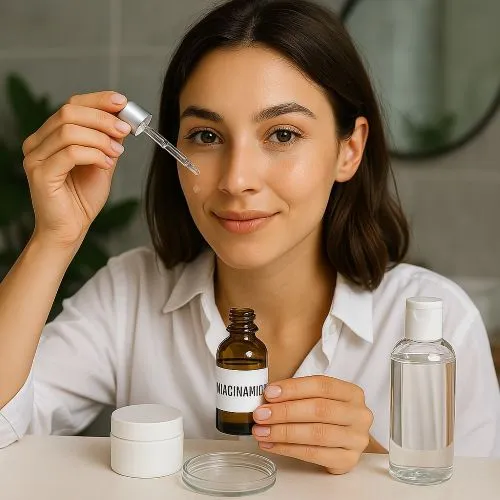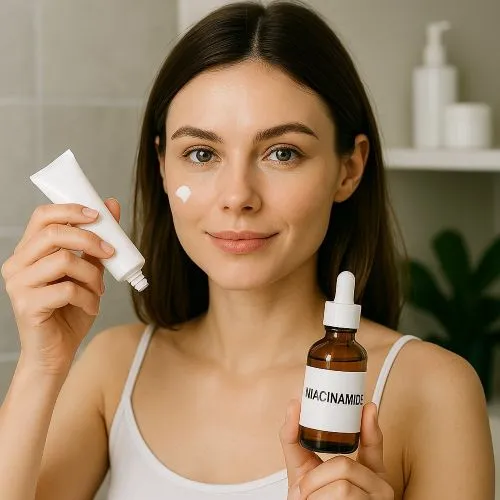-
 DIY: Video master classes
DIY: Video master classes
-
 Aromatherapy
Aromatherapy
-
 Felting master classes
Felting master classes
-
 Eating at home
Eating at home
-
 DIY cosmetics for children
DIY cosmetics for children
-
 Cooking recipes
Cooking recipes
-
 Detergents, cleaning products with your own hands
Detergents, cleaning products with your own hands
-
 Soap making as a business
Soap making as a business
-
 Natural cosmetics. Raw materials for cosmetics and soap.
Natural cosmetics. Raw materials for cosmetics and soap.
-
 Natural oils in cosmetics
Natural oils in cosmetics
-
 News
News
-
 Recipes for balms and conditioners
Recipes for balms and conditioners
-
 Bath Bomb Recipes
Bath Bomb Recipes
-
 Cream recipes. Cream making.
Cream recipes. Cream making.
-
 Lotion recipes. Gel recipes.
Lotion recipes. Gel recipes.
-
 Mask recipes
Mask recipes
-
 Soap recipes. Base soap. Soap from scratch.
Soap recipes. Base soap. Soap from scratch.
-
 Recipes for all occasions
Recipes for all occasions
-
 Natural shampoo recipes
Natural shampoo recipes
-
 Healthy Nutrition Recipes
Healthy Nutrition Recipes
-
 Scrub recipes. Massage tiles. Ubtan
Scrub recipes. Massage tiles. Ubtan
-
 DIY candles
DIY candles
-
 Reference materials, questions, tips
Reference materials, questions, tips
-
 Startup - soap production
Startup - soap production
-
 Hair care. Tips, recipes
Hair care. Tips, recipes
-
 Facial skin care. Cleansers.
Facial skin care. Cleansers.
-
 Body care. Tips, recipes
Body care. Tips, recipes
-
 Photo Reviews
Photo Reviews
-
 Chocolate Handmade
Chocolate Handmade
Niacinamide in the formula: how not to spoil the active ingredient and maintain efficiency
 Niacinamide, a form of Vitamin B3, has emerged as a true hero in the world of skincare. Its remarkable ability to address multiple skin concerns—from regulating sebum and minimizing pores to strengthening the skin barrier and calming redness—makes it an indispensable ingredient. While professionally formulated niacinamide products are widely available, many enthusiasts choose to create their own, driven by a desire for ingredient transparency, cost-effectiveness, and ultimate customization. However, working with this powerful active requires a deep understanding of its stability to ensure its potency is not compromised. This guide will reveal the essential rules of formulating with niacinamide, provide three detailed recipes, and explain why a DIY approach, when done correctly, can surpass industrial alternatives.
Niacinamide, a form of Vitamin B3, has emerged as a true hero in the world of skincare. Its remarkable ability to address multiple skin concerns—from regulating sebum and minimizing pores to strengthening the skin barrier and calming redness—makes it an indispensable ingredient. While professionally formulated niacinamide products are widely available, many enthusiasts choose to create their own, driven by a desire for ingredient transparency, cost-effectiveness, and ultimate customization. However, working with this powerful active requires a deep understanding of its stability to ensure its potency is not compromised. This guide will reveal the essential rules of formulating with niacinamide, provide three detailed recipes, and explain why a DIY approach, when done correctly, can surpass industrial alternatives.
The Niacinamide Powerhouse: A Skincare Multitasker
Before diving into the "how," it is crucial to understand the "why." Niacinamide's versatility stems from its ability to interact with cells at a fundamental level.
-
Sebum Regulation: It helps to normalize sebum, or oil, production, leading to a visible reduction in shine and the appearance of clogged pores. This makes it a perfect ingredient for oily and acne-prone skin.
-
Barrier Restoration: Niacinamide stimulates the synthesis of ceramides, which are essential lipids that form the skin’s natural protective barrier. A strong barrier means healthier, more resilient skin that is better at retaining moisture and fighting off environmental damage.
-
Soothing and Anti-inflammatory: Its ability to calm inflammation makes it effective at reducing redness and irritation associated with conditions like rosacea or acne.
-
Hyperpigmentation: Niacinamide can help to fade post-inflammatory hyperpigmentation and even out skin tone.
Given these benefits, preserving the integrity of this active in your formula is the key to achieving real results.
The Science of Stability: How to Not Spoil Your Niacinamide
The primary challenge in formulating with niacinamide is maintaining its stability. The most common mistakes lead to its conversion into nicotinic acid, which can cause unpleasant side effects like skin flushing, itching, and irritation.
The pH Factor: The most critical rule for niacinamide is to maintain a pH within its optimal range. Niacinamide is most stable and effective between a pH of 5.0 and 6.0. When the pH drops below 4.0 or rises above 7.0, it can convert to nicotinic acid. Therefore, accurate pH testing of your final product is absolutely essential.
The Temperature Factor: Niacinamide is a heat-stable molecule, which is a significant advantage. However, when formulating, it is best practice to add it to the cool-down phase (below 40°C) of your formula. This ensures that other heat-sensitive ingredients, such as botanical extracts or preservatives, are not damaged.
Compatibility with Other Actives: A common myth is that niacinamide should not be mixed with Vitamin C. In modern formulations, this is not an issue. When both actives are formulated at a skin-friendly pH of 5.0-6.0, they can coexist beautifully and even enhance each other's effects.
The Role of a Preservative: Any cosmetic product containing water must have a broad-spectrum preservative to prevent the growth of bacteria, mold, and yeast. Niacinamide itself does not preserve the formula. Skipping this step will render your product unsafe within days.
Hygiene is Essential: All your equipment, including beakers, stirrers, and storage bottles, must be thoroughly cleaned and sterilized. This prevents microbial contamination from the start.
The DIY Advantage: Overcoming Industrial Limitations
By mastering the art of formulating with niacinamide at home, you gain significant benefits over industrial products.
-
Purity and Ingredient Control: You have complete command over the ingredients, allowing you to avoid cheap fillers, synthetic fragrances, parabens, or harsh alcohols that can cause skin irritation.
-
Freshness and Potency: Homemade formulas are made in small, fresh batches. Unlike commercial products that may sit on shelves for months, your active ingredients are at their peak efficacy.
-
Cost-Effectiveness: The raw powder of niacinamide is inexpensive. A single small bag can create many bottles of high-quality serum, resulting in immense savings compared to luxury skincare brands.
-
Ultimate Customization: You can tailor the concentration of niacinamide (typically between 2% and 10%) and combine it with other actives that your skin needs, creating a truly bespoke product.
Three Detailed Recipes for Formulating with Niacinamide
These recipes are designed for approximately 50 grams of finished product. Always remember to use a digital scale and a cosmetic-grade preservative.
Recipe 1: Basic Mattifying Toner for Oily Skin
This simple toner focuses on regulating sebum and minimizing pores, perfect for a beginner.
Ingredients:
-
Distilled Water: 43 g
-
Niacinamide (Vitamin B3) Powder: 5 g
-
Witch Hazel (Alcohol-Free): 2 g
-
Preservative (e.g., Geogard 221): 0.5 g
-
Lactic Acid Solution (10%): q.s. (as needed for pH adjustment)
Preparation:
-
Weigh your distilled water into a sterilized beaker.
-
Add the niacinamide powder and stir until it is completely dissolved.
-
Add the witch hazel to the mixture and stir gently.
-
Add your chosen preservative and mix thoroughly for at least two minutes.
-
Use a pH strip or a pH meter to test the mixture. The goal is a pH of 5.0-6.0.
-
Add lactic acid solution drop by drop, stirring and re-testing after each drop, until the desired pH is reached.
-
Transfer your toner to a sterilized spray or squeeze bottle.
Recommendations for Use: Apply to a cleansed face in the morning and evening using a cotton pad or by spritzing directly onto the skin. Follow with a lightweight, non-comedogenic moisturizer.
Storage: Store in a cool, dark place. This toner will be stable for up to 6 months with a preservative.
Recipe 2: Restorative & Soothing Serum for Sensitive Skin
This formula is designed to strengthen the skin's barrier and calm redness, making it ideal for sensitive or compromised skin.
Ingredients:
-
Distilled Water: 41.5 g
-
Niacinamide Powder: 2.5 g
-
Panthenol (Vitamin B5): 5 g
-
Hyaluronic Acid Solution (1% stock): 10 g
-
Preservative (e.g., Euxyl PE 9010): 0.5 g
-
Lactic Acid Solution (10%): q.s. (as needed for pH adjustment)
Preparation:
-
Weigh your distilled water into a sterilized container.
-
Add the niacinamide powder, panthenol, and hyaluronic acid solution and stir gently until everything is dissolved and a light gel forms.
-
Add your chosen preservative and stir for two to three minutes.
-
Test the pH of your serum. It should be between 5.0 and 5.5 for a soothing effect.
-
Adjust the pH with lactic acid solution if necessary.
-
Transfer the finished serum to a sterilized dropper bottle.
Recommendations for Use: Apply a few drops to a clean, damp face. Gently pat into the skin, focusing on areas of redness or irritation. Use twice daily, followed by your preferred moisturizer.
Storage: Store in a cool, dark place away from direct sunlight. The shelf life is up to 6 months.
Recipe 3: Brightening & Anti-Aging Serum
This advanced recipe combines niacinamide with a powerful antioxidant to tackle hyperpigmentation and fine lines.
Ingredients:
-
Distilled Water: 40 g
-
Niacinamide Powder: 5 g
-
Magnesium Ascorbyl Phosphate (MAP) Powder: 2.5 g
-
Vegetable Glycerin: 2.5 g
-
Hyaluronic Acid Solution (1% stock): 10 g
-
Preservative (e.g., Geogard 221): 0.5 g
-
Citric Acid Solution (10%): q.s. (as needed for pH adjustment)
Preparation:
-
Weigh the distilled water into a sterilized container.
-
Add the niacinamide powder and MAP powder and stir until completely dissolved. Note that MAP is a stable form of Vitamin C and works well with niacinamide at a pH of 6.0.
-
Add the vegetable glycerin and hyaluronic acid solution and stir gently.
-
Add the preservative and mix for several minutes.
-
Test the pH of your serum. The ideal pH for this combination is around 6.0.
-
Adjust the pH with citric acid solution if needed.
-
Transfer the serum to a sterilized, opaque dropper bottle to protect the Vitamin C from light.

Recommendations for Use: Apply a few drops of the serum to a clean face in the morning, followed by a moisturizer and sunscreen.
Storage: Store in a cool, dark place. The shelf life is up to 6 months.
Conclusion: Your Skin, Your Rules
Creating your own niacinamide products is a rewarding journey into personalized skincare. By understanding the critical factors of pH, temperature, and preservation, you can confidently formulate products that are not only safe and effective but also perfectly tailored to your skin's unique needs. This knowledge empowers you to step beyond commercial offerings and unlock the full potential of niacinamide, creating a routine that is pure, potent, and uniquely yours.
Mylo Opt Cosmetics Blog – Your Reliable Guide to Beauty and Care
Welcome to the Mylo Opt cosmetics blog! Here, you will find valuable advice, interesting recipes, and professional recommendations for creating soap, cosmetics, and candles with your own hands. Our blog is designed for anyone passionate about natural cosmetics, looking for new ideas, and wanting to learn more about producing high-quality skincare and haircare products. We share tested recipes, useful tips, and the latest news from the world of cosmetics.
Why Choose the Mylo Opt Cosmetics Blog?
Mylo Opt is not just an online store; it is a community of people passionate about creating natural cosmetics. Here are a few reasons why our blog will be useful to you:
- Experience and Expertise: Our authors are experienced cosmetologists, soap makers, and aromatherapy specialists. We share reliable and tested recipes that have undergone thorough testing and received positive feedback.
- Credibility and Authority: We ensure that all information in our blog is up-to-date and reliable. We reference scientific research and verified sources so that you can trust the quality of the information provided.
- Reader-Focused: Our content is tailored to you – our readers. We strive to answer your questions, solve your problems, and inspire new achievements in the world of natural cosmetics.
Popular Products from the Mylo Opt Online Store
Before we move on to recipes and tips, let us introduce you to the most popular products from our online store, which will help you create high-quality and natural cosmetics:
- Soap Bases: High-quality soap bases allow you to create beautiful and beneficial handmade soaps. We offer glycerin bases, bases with added oils and extracts, as well as transparent and white bases.
- Fragrance Oils and Fragrances: Give your products a unique scent with our fragrance oils and fragrances. We offer a wide range of scents – from fresh and floral to spicy and woody.
- Essential Oils: Essential oils are natural components that not only add fragrance to products but also offer beneficial properties for the skin and hair. Our range includes lavender, mint, eucalyptus, lemon, and many other oils.
- Active Ingredients: Vitamins, antioxidants, hyaluronic acid, and other active ingredients help improve the properties of your cosmetics. We offer only tested and high-quality components.
- Pigments and Dyes: Give your products bright and lasting colors with our pigments and dyes. They are safe for the skin and suitable for use in soap, cosmetics, and candles.
- Emulsifiers and Thickeners: To create creams and lotions, you will need emulsifiers and thickeners. We offer quality ingredients that help you achieve the desired consistency and stability of the product.
- Soap and Candle Molds: Create unique items with our soap and candle molds. Our range includes molds of various sizes and designs.
- Everything for Candles: Wax, wicks, fragrances, and dyes for candles – we have everything you need to create beautiful and fragrant candles.
Recipes and Tips for Making Handmade Soap
Cold Process Soap for Beginners
Making cold process soap is an exciting process that allows you to control all the ingredients and create unique recipes. Here is one simple cold process soap recipe for beginners:
Ingredients:
- 500 g olive oil
- 300 g coconut oil
- 200 g palm oil
- 150 g castor oil
- 120 g lye (sodium hydroxide)
- 300 ml distilled water
- Essential oils (lavender, mint, eucalyptus)
- Pigments or natural dyes (optional)
Process:
- Prepare all ingredients and tools. Always use protective gloves and goggles, as lye can be dangerous.
- Weigh the lye and water. Slowly add the lye to the water, stirring until it fully dissolves. Allow the mixture to cool to 40-45°C.
- Weigh the oils and melt them in a water bath. When the oils and lye solution reach the same temperature (about 40-45°C), slowly pour the lye into the oils, stirring constantly.
- Use an immersion blender to mix until trace (when the mixture thickens and leaves a trail when stirred).
- Add essential oils and pigments if desired. Mix thoroughly.
- Pour the mixture into a prepared mold and cover with a towel. Let the soap harden for 24-48 hours.
- Remove the soap from the mold and cut it into bars. Allow the soap to cure for 4-6 weeks before use.
Homemade Cosmetics Recipes
DIY Moisturizing Cream
Creating a moisturizing cream at home allows you to control the ingredients and adapt the recipe to your needs. Here is a simple recipe for a moisturizing cream:
Ingredients:
- 50 ml rose water
- 50 ml distilled water
- 10 g emulsifier (e.g., Olivem 1000)
- 10 ml jojoba oil
- 5 ml avocado oil
- 5 drops lavender essential oil
- 2 drops tea tree essential oil
Process:
- Weigh all the ingredients.
- In a water bath, melt the emulsifier with the oils until smooth.
- Separately, heat the water phase (rose water and distilled water) to the same temperature as the oil phase.
- Slowly pour the water phase into the oil phase, stirring constantly.
- Use an immersion blender to emulsify until you achieve a creamy consistency.
- Add essential oils and mix thoroughly.
- Pour the cream into a sterilized jar and allow it to cool.
DIY Candle Recipes
Aromatic Soy Candle
Creating aromatic candles is a creative process that allows you to experiment with scents and designs. Here is a simple recipe for a soy candle:
Ingredients:
- 200 g soy wax
- 20 ml fragrance oil (e.g., vanilla or lavender)
- Wick for candles
- Dyes (optional)
- Glass or metal candle mold
Process:
- Melt the soy wax in a water bath until liquid.
- Add the fragrance oil and dyes if desired. Mix thoroughly.
- Secure the wick in the center of the candle mold.
- Slowly pour the melted wax into the mold, holding the wick.
- Allow the candle to fully harden (about 24 hours).
- Trim the wick to the desired length and enjoy your aromatic candle.
Tips for Beginners in Cream Making
- Learn the Basics: Before starting to create creams, it is important to learn the basic principles and ingredients used in cream making.
- Experiment with Formulas: Do not be afraid to experiment with different ingredients and proportions to find the perfect formula for your skin.
- Use Quality Ingredients: The effectiveness and safety of your product depend on the quality of the ingredients. Always choose tested and natural components.
- Maintain Hygiene: It is important to maintain cleanliness and sterility when creating cosmetics to avoid contamination and spoilage of the product.
- Start with Simple Recipes: For beginners, it is best to start with simple recipes to master the basic techniques and principles of cream making.
Conclusion
Our Mylo Opt cosmetics blog is your reliable source of information and inspiration in the world of natural cosmetics. We share useful tips, tested recipes, and the latest news to help you create quality and effective products for skin, hair, and home care. Subscribe to our blog, follow the updates, and discover new opportunities in the world of natural cosmetics with Mylo Opt!





